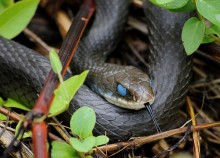Black Racer snakes are predators and eat rats, mice, lizards, moles, insects, salamanders, birds, eggs, small snakes (even the young of their own species), rodents and frogs.
Despite its Latin name, Coluber constrictor, the Black Racer snake is more likely to crush its victim into the ground or suffocate it rather than coiling around it in typical constrictor fashion.
Black Racer snakes travel rapidly, hence their name. They can travel at speeds of up to 10 miles per hour and use their speed to chase their victims, grab them with their strong jaws and swallow them alive.
Black Racer snakes can climb small trees and bushes to feed on birds and their eggs. They can also swim. They utilise a variety of habitats including dry or moist woodlands, rocky ledges, pastures, overgrown fields and the edges of wetlands. They are diurnal, meaning that they are active primarily during the day, and can tolerate high temperatures that see other snakes seeking shade. They can often be seen hunting and foraging, seeking shelter at night and in cooler weather.
Black Racer snakes mate in spring. The females lay up to 36 eggs in early summer, which are coated with small nodules like grains of sand. They hatch in late summer or early autumn. The hatchling Black Racers are up to 14 inches long.
The Black Racer snake was nominated as the official state reptile of Ohio in 1995. It is beneficial to the state farmers as it eats the rodents.
Despite its Latin name, Coluber constrictor, the Black Racer snake is more likely to crush its victim into the ground or suffocate it rather than coiling around it in typical constrictor fashion.
Black Racer snakes travel rapidly, hence their name. They can travel at speeds of up to 10 miles per hour and use their speed to chase their victims, grab them with their strong jaws and swallow them alive.
Black Racer snakes can climb small trees and bushes to feed on birds and their eggs. They can also swim. They utilise a variety of habitats including dry or moist woodlands, rocky ledges, pastures, overgrown fields and the edges of wetlands. They are diurnal, meaning that they are active primarily during the day, and can tolerate high temperatures that see other snakes seeking shade. They can often be seen hunting and foraging, seeking shelter at night and in cooler weather.
Black Racer snakes mate in spring. The females lay up to 36 eggs in early summer, which are coated with small nodules like grains of sand. They hatch in late summer or early autumn. The hatchling Black Racers are up to 14 inches long.
The Black Racer snake was nominated as the official state reptile of Ohio in 1995. It is beneficial to the state farmers as it eats the rodents.

